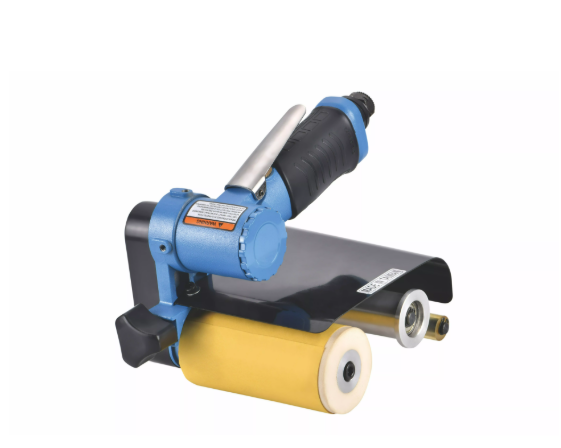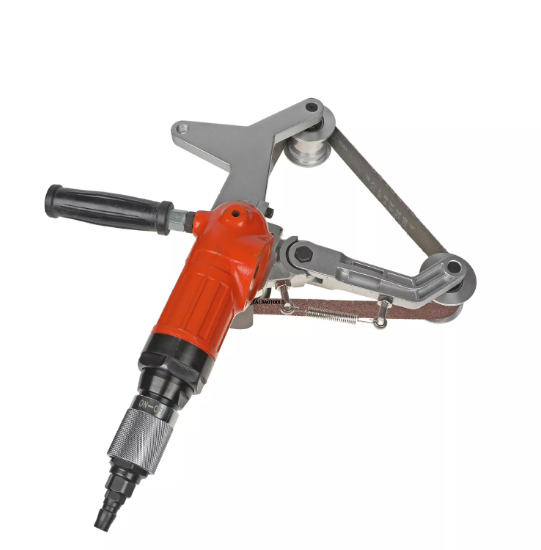

Views: 0 Author: Site Editor Publish Time: 2025-03-18 Origin: Site








Are you choosing between air belt sanders and electric sanders for your workshop? The decision can impact your work efficiency and long-term costs.
In this post, we’ll explore the differences between air and electric sanders. We’ll cover key factors like cost, performance, maintenance, and usability to help you make the best choice.

An air belt sander is a tool powered by compressed air instead of electricity. This makes it lighter and more compact than electric sanders. By using air pressure, it delivers high-speed sanding that can handle various surfaces efficiently.
Air belt sanders are popular in workshops due to their simplicity and powerful performance. They’re typically smaller, making them easier to handle, especially for long sanding sessions.
Material of Construction
Air sanders are often made with durable aluminum housing. This keeps them lightweight, while also absorbing vibrations for a smoother sanding experience.
Air Pressure Requirements
These sanders operate at an optimal pressure of around 90 PSI. Too little or too much pressure can affect performance, so it's important to ensure your air compressor is compatible.
Performance Features
Air sanders can reach speeds of up to 12,000 RPM in 5 and 6-inch models, making them efficient for quick sanding tasks. Their high speeds help reduce sanding time.
Size and Ergonomics
Compared to electric sanders, air sanders are typically smaller and lighter, which makes them easy to maneuver, especially for detailed or extended work.
Additional Insight
Air sanders do not have the elongated handles seen in electric models, making them more compact and easier to handle in tight spaces.

An electric sander is a tool powered by electricity, using an electric motor to drive the sanding action. Unlike air sanders, which use compressed air, electric sanders rely on an electrical connection to perform the sanding task. This makes them versatile and convenient, as you don't need an air compressor.
Electric sanders typically feature a brushless motor, which provides greater durability and efficiency. These motors are cooled by internal fans to reduce heat buildup, ensuring longer use without the risk of overheating.
Speed and Versatility
Electric sanders offer adjustable speeds ranging from 8,000 to 12,000 RPM. This flexibility allows you to tailor the sander’s speed to the task at hand, whether you need fast sanding or a slower, more controlled approach.
Durability and Reliability
Brushless DC motors are commonly found in electric sanders. These motors are known for their longer lifespan and reduced wear and tear, making them a reliable option for both home and professional workshops.
Overheating Protection and Efficiency
To prevent overheating during high-speed use, electric sanders have internal fans and cooling systems. These features help maintain consistent performance and reduce the chances of the motor shutting down unexpectedly.
Dust Extraction Options
Many electric sanders are designed with dust extraction capabilities. This feature helps keep your workspace cleaner by capturing the dust and debris created while sanding.
Additional Insight
Electric sanders are built to manage heat more effectively. The cooling systems prevent the motor from getting too hot, which is especially useful when working at high speeds for extended periods.
Air sanders and electric sanders differ significantly in power and speed. Pneumatic sanders often offer faster speeds, with some models like those from Uneeda reaching up to 12,000 RPM for 5 and 6-inch units. This high speed makes air sanders ideal for aggressive sanding tasks.
Electric sanders, on the other hand, offer more controlled speeds, adjustable between 8,000 and 12,000 RPM. This range gives you more flexibility, allowing for both fast and precise sanding depending on the material and task.
Additional Insight: Air sanders are great for rapid material removal, while electric sanders provide greater control, especially for detailed or delicate work.
Air sanders are generally lighter than electric models, making them easier to handle during long sanding sessions. The lack of an electric motor in pneumatic sanders reduces their weight, allowing for less fatigue during extended use.
Electric sanders tend to be bulkier due to their internal motors and power components. While this may make them heavier, they are designed for heavier-duty tasks and often provide more consistent power for challenging materials.
Air sanders are built with durable materials like aluminum housing, designed to absorb vibrations and withstand continuous use. However, without proper maintenance, they can wear out quickly. Regular lubrication and air filter care are essential for their long-term durability.
Electric sanders also have a reputation for reliability, especially when equipped with brushless motors. Though durable, they do require maintenance to prevent overheating. With proper care, they can last a long time and continue to perform efficiently.
Maintaining an air sander is crucial for its performance. Regular lubrication and air filter maintenance prevent common issues, such as locked bearings and reduced power. If not properly cared for, pneumatic sanders can fail prematurely.
Additional Insight: Pneumatic sanders require more attention to maintenance. If the air filters and internal components are neglected, they may suffer from performance issues, resulting in costly repairs.
Electric sanders typically require less maintenance than pneumatic models. The most common upkeep is cleaning the dust extraction system. Overheating can be an issue, but it’s easy to recalibrate the motor and resume sanding after a brief cooldown.
With proper use and minimal maintenance, electric sanders can last a long time, offering reliable performance.
Additional Insight: If an electric sander overheats, recalibrating it is a simple and quick process that restores its functionality.
When choosing between air belt sanders and electric sanders, the initial cost is a key factor. Electric sanders typically have a higher upfront price. However, their long-term operational costs are lower due to their energy efficiency. On average, electric sanders run at about $0.35 per day for 8-hour use.
Pneumatic sanders, while more affordable initially, require an air compressor to operate. The cost of maintaining the compressor and potential repairs can add up over time.
Additional Insight: Although electric sanders may cost more initially, their lower operational costs over time often make them the better long-term investment.
Air sanders require a reliable air compressor to function properly. You need a stable air supply, typically around 90 PSI, for optimal performance. This can be a limiting factor in some workshops, especially those that don’t use many air-powered tools.
On the other hand, electric sanders can be used anywhere there's an electrical outlet, making them more versatile for spaces without a compressed air system.
Additional Insight: If you don’t already have a compressor in your workshop, electric sanders may be more convenient and cost-effective in the long run.
For home projects, electric sanders are often the better option. They are easy to transport and use, as they only require a plug-and-play setup. This makes them ideal for smaller jobs around the house or for hobbyists.
Electric sanders are also more portable since you won’t need to bring along an air compressor or worry about air pressure.
Additional Insight: DIYers and hobbyists will appreciate the convenience of electric sanders, especially when working on smaller projects or in spaces without air supply.
In professional workshops or industrial environments, air belt sanders excel. Their powerful motors and ability to run continuously make them the ideal choice for large-scale, high-output tasks. They offer consistent speed and performance, which is essential in heavy-duty environments.
Air sanders also tend to be more cost-effective over time when used in high-volume work, making them popular in industrial settings.
Additional Insight: Pneumatic sanders are often preferred in industrial environments due to their power, durability, and cost-effectiveness, especially for large projects.
Air belt sanders are generally lighter than electric models, which makes them ideal for extended use. The reduced weight helps minimize hand fatigue, allowing you to work longer without discomfort.
One of the key benefits of pneumatic sanders is their lower upfront cost. Compared to electric sanders, air sanders are often more budget-friendly, making them a good option for those on a tighter budget.
In professional or factory settings, air sanders shine. They provide consistent power and high speeds, which are perfect for heavy-duty tasks like sanding large surfaces quickly and efficiently.
Additional Insight: While air sanders are affordable, their performance is limited by the air supply in your shop. Ensure your compressor can handle the required PSI for optimal results.
Electric sanders are easy to use. They don't require an air compressor, so all you need is a nearby power outlet. This makes them incredibly convenient for home workshops and DIY projects.
Electric sanders offer adjustable speeds, ranging from 8,000 to 12,000 RPM. This versatility allows you to choose the right speed for the task, whether you need aggressive sanding or fine detail work.
Electric sanders tend to have lower energy consumption over time. With proper maintenance, they remain efficient for years, making them a reliable option for ongoing projects.
Additional Insight: Electric sanders require less overall maintenance, making them a more convenient option for those who prefer a hassle-free experience and easy upkeep.
When deciding between an air belt sander and an electric sander, consider several key factors. First, think about your workshop size and whether you have access to compressed air. If you have a larger space or already use air tools, a pneumatic sander could be more efficient.
Another important factor is how often you plan to use the sander and for which projects. If you're working on small or occasional tasks, an electric sander might be more convenient. But for continuous, heavy-duty work, an air sander could perform better.
Also, consider your personal preference for maintenance. Air sanders typically require more upkeep, including lubrication and air filter care, while electric models are lower maintenance.
Home Workshops: For smaller projects, electric sanders are generally the better choice. They are easy to transport, don’t require an air compressor, and are ready to use straight from the box.
Professional Shops: In a professional setting, where long hours of sanding are common, air sanders excel. They can handle high-speed sanding with consistent power, making them ideal for heavy-duty tasks.
Additional Insight: If you use multiple air tools in your workshop, an air sander may be more efficient. Air-powered tools often work well together, especially in larger industrial environments, where they can all draw from the same air supply.
Air belt sanders are lighter and more affordable, ideal for heavy-duty use in professional settings. Electric sanders are more versatile, easier to use, and require less maintenance, making them great for home workshops.
Consider factors like maintenance, cost, and performance when choosing the right sander. Your workshop size and usage frequency will also help guide your decision.
A: Yes, air sanders require regular lubrication to maintain smooth operation. Neglecting this can lead to premature failure of bearings and other components.
A: Electric sanders can overheat, but they have systems to reduce heat buildup, such as internal fans. Proper calibration helps avoid overheating.
A: Electric sanders are often more cost-effective for small workshops since they don’t require an air compressor and have lower operational costs.
A: Regularly lubricate the sander, maintain air filters, and check for any wear. Proper upkeep will ensure it performs well over time.